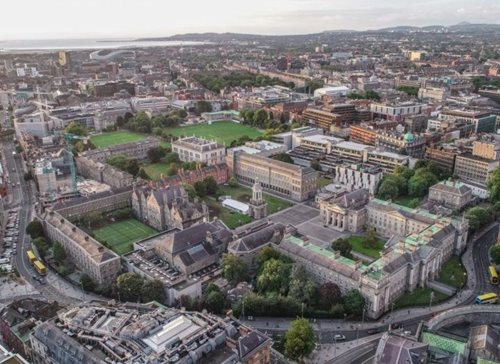 A drone view of the existing campus. Image: Trinity College Dublin
A drone view of the existing campus. Image: Trinity College Dublin
In July, it was reported that the university has major ambitions for Dublin, including a plan to build a 5.5-acre campus in the Grand Canal Dock district. This campus will also be a hub for start-ups and a landing zone for foreign direct investment (FDI) companies as well as home to a community of venture capital companies, and public and civic spaces.
The Estates Strategy published last month included flagship projects such as the new Trinity Business School, which will open in March 2019. The Printing House Square development, which is also due to open in 2019, will provide on-campus student accommodation for up to 250 students along with a range of student services.
The strategy also includes the E3 Engineering, Environment and Emerging Technologies initiative at Trinity College Dublin (TCD). Central to the vision of E3 is the construction of the Learning Foundry, a state-of-the-art 6,086 sq m facility based on the main TCD campus. It will deliver new teaching facilities and an innovative interactive learning space for undergraduate and postgraduate students.
“Space is essential to community, and in Trinity our sense of community comes so much from sharing this beautiful campus,” said TCD provost Dr Patrick Prendergast. “Better management of space will improve connectivity across the university. The building of new transformative spaces, like the E3 Learning Foundry, will enable new approaches in teaching.”
Integrity and intention
Other capital developments will include the expansion of student accommodation at Trinity Hall in Dartry to house 300 new beds for students, as well as the expansion of the School of Law and the refurbishment of the Arts Block.
As mentioned, a masterplan is being developed for the Grand Canal Innovation District centred on a new campus in the heart of Dublin’s docklands. There are also plans for the Trinity St James’s Cancer Institute, which will provide a comprehensive cancer care centre on the St James’s Hospital campus.
As well as these capital projects, the Estates Strategy incorporates a long-term refurbishment plan and conservation plan, which will take in the library as well as other key buildings on campus. It also provides for a residential strategy that will serve the long-term needs of staff and students.
“Trinity has one of the most significant campuses worldwide,” said university bursar Veronica Campbell. “As a university campus, it first and foremost serves the needs of the college community. It provides an environment that supports student learning, enables research, and creates an ambience in which the Trinity community connects and flourishes. We aim to provide facilities that support our students and staff for all their needs, and ensure there is a plan to sustain growth over the long term.
“The Estates Strategy will allow the campus to continue to evolve and support the academic mission, by improving the efficiency and quality of learning space and by introducing adaptive reuse of buildings to meet future requirements. It will upgrade heritage buildings, support growth areas and position the campus for the future.”
John Kennedy
This article first appeared on www.siliconrepublic.com and can be found at:
https://www.siliconrepublic.com/innovation/trinity-college-campus-future-estates-strategy



